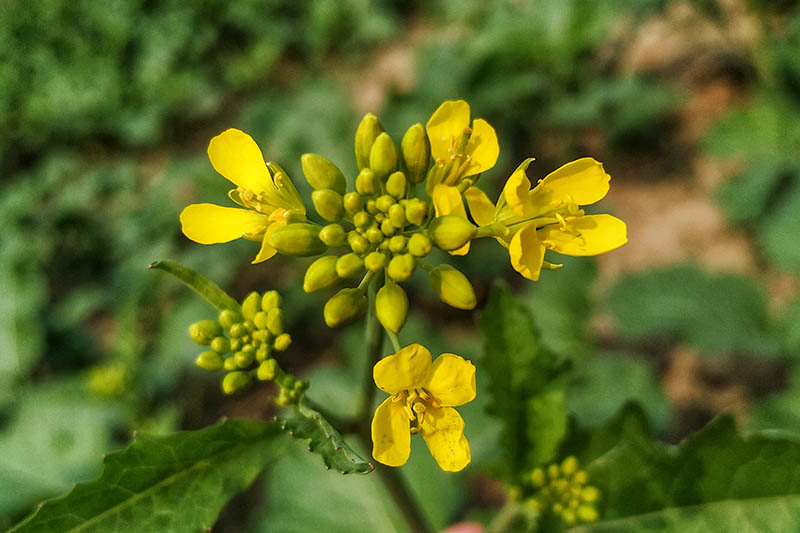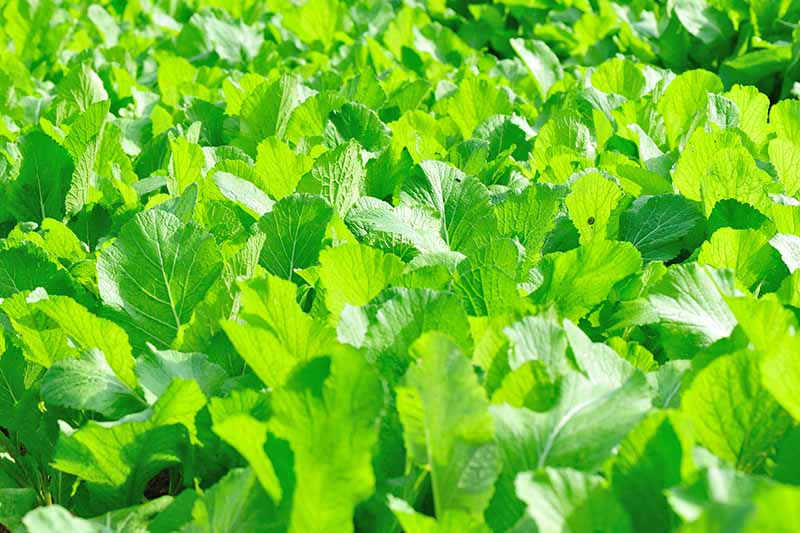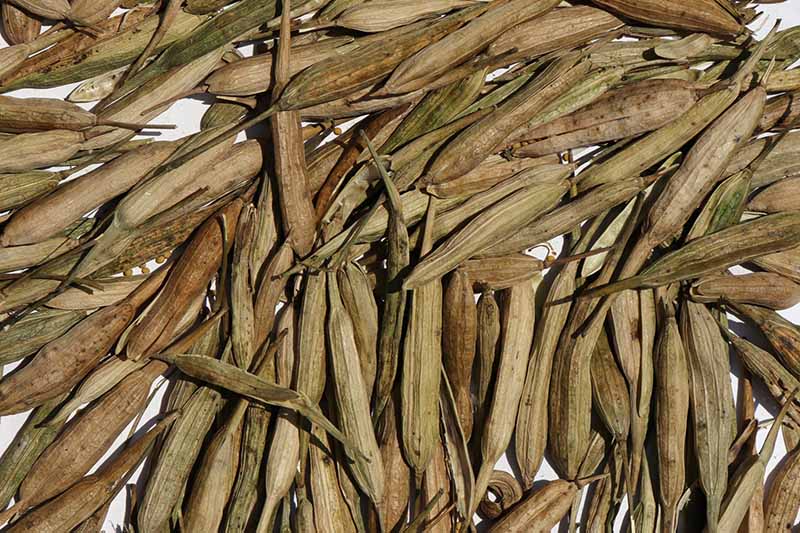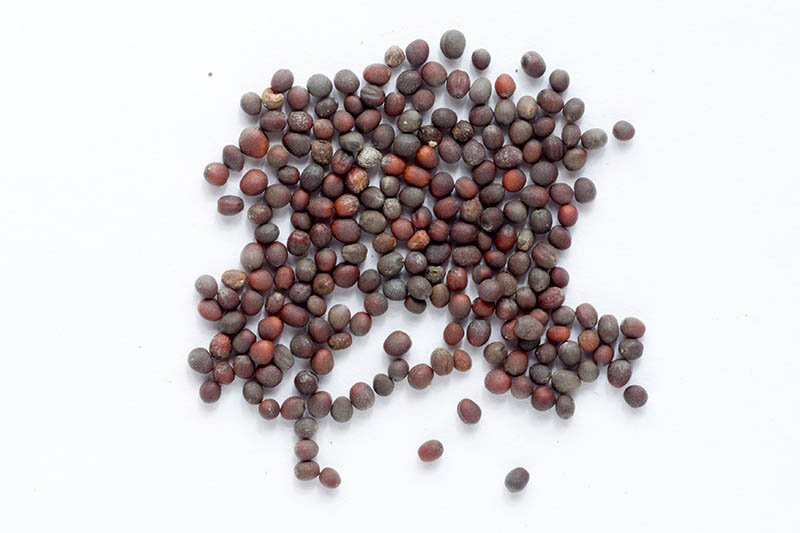what to do with mustard thats gone to seed

Information technology seems similar you lot only take to look abroad for a 2nd, or maybe a twenty-four hour period, and your mature mustard greens will start flowering.
And non long later that, they're total of seed pods.
In some circumstances you lot can collect the seeds and save them for replanting next season or to share with friends.

We link to vendors to help you find relevant products. If you buy from one of our links, we may earn a commission .
Mustard greens are a cool-weather crop, usually grown in the spring or fall and are typically set up to harvest after thirty-60 days, depending on the variety.
The most popular types to abound for the spicy, flavorful leaves are Brassica juncea, B. rapa var. japonica and B. rapa var. narinosa.
You can learn more near how to grow mustard greens in our guide.
In this article, I'm going to cover how to save seeds from your mustard greens for planting.
What You lot'll Learn
- Planting Considerations
- When to Harvest
- Separating and Storing
Planting Considerations
When mustard greens bolt the leaves become excessively bitter, putting an end to your harvest.
The plants send up flower stalks with minor yellow blooms. After the flowers have opened upward, they attract pollinators, and after pollination the pods start to form.

If you are intending to harvest the seeds, you need to go along in listen that mustard greens can cantankerous-pollinate with other varieties of the same species, and if that happens, the saved seeds won't abound true to the variety you planted.
Mizuna, for example, is a variety of B. rapa, as are all types of turnip. If y'all have turnips growing nearby, you run the chance of cross-pollination.
In that location is no danger of cross pollination between different Brassica species, so y'all don't need to worry if you are growing kale or cabbage nearby.
If you are growing a hybrid diverseness, plants grown from saved seed volition not produce true to the parent plant. So cheque your seed packet to make sure the cultivars you have called are open-pollinated or heirloom varieties.

In addition to cross pollination, if the plants are exposed to wild mustard or other cruciferous weeds and volunteers, certain pathogens like Colletotrichum higginisianum that causes anthracnose, tin make their way from the infected wild plants into your cultivated greens.
The plants can then produce infected seed and spread the disease to the next generation of plants. This is thankfully quite rare, simply if yous doubtable a transfer of infection, that's a skilful reason to purchase a new package of seeds instead of trying to save them from your plants.
If you're not growing related plants and are fairly certain yous don't have an issue with disease or volunteers, the seed-saving process is fairly simple.
Timing is everything, and then keep reading to learn when to make your move.
When to Harvest
As with any member of the cabbage family unit you abound in your vegetable garden, it's particularly important not to found mustard greens in the aforementioned place ii years in a row. And y'all shouldn't plant any of their Brassica relatives in that same spot, either – such equally broccoli, turnips, or kale.

I sympathise if you're wondering, "What does this churr about crop rotation have to do with saving seeds?" The reply: If you lot permit these spicy vegetables to get to seed in the garden, you take chances having volunteers grow in that same infinite adjacent year.
And so y'all'll exist establishing a haven for Brassica insect pests and soil borne diseases. Instead, make sure to harvest before the pods offset popping.

Just yous tin can't practice this too early, as the seeds won't exist viable if yous choice the pods earlier they are ready.
You demand to allow the pods to dry and turn brown on the establish. To make sure they're gear up, slit one or two of the pods open and make sure the seeds within are brownish, or in the case of some varieties like blood-red leaf mizuna, a dusty rose or plum color.
If they're green, light green, or white, they aren't even so set to harvest.
The pods may not all dry out at the same time, those closest to the base of the blossom stalk tend to dry showtime. You can pick these off individually or simply wait until virtually of the pods on the stem are ready. Some of the drier pods may split and drop their seed.
Separating and Storing
To save mustard greenish seeds, yous can remove the dry pods individually, cut off the unabridged branch, or you can pull up the plant.

Advisedly separate the pods from the flower stalk and set them on a drop textile or in a shoebox or bucket. Some of the seeds will drop out of the pods on their ain.
For the others, yous tin can rub the dry pods betwixt your thumb and forefinger to release them.
If you take a huge batch, you can set them out on a make clean canvas or tarp and walk over them with clean-soled shoes until the pods pop open up and release their contents.
Remove big pieces of crust and droppings by hand, and separate the residual past winnowing.

Discard the stalks or spent plants, whichever y'all cut for the harvest, and the crust.
Store the seeds in a modest craft paper envelope, a jar with a screw-on chapeau, or a plastic storage container. Be sure to label the storage container with the date of collection and the variety.
Place them in a cool dry place and they should stay viable for upward to four years.
Mustard Greens, Year after Year
Saving seeds from your ain plants is an economical way to enjoy your favorite varieties flavour after season. And instead of feeling disappointed when your plants bolt, you lot can see it every bit an opportunity instead!

Plus, the pretty yellow flowers attract pollinators and beneficial insects to the garden.
Did you let any of your mustard plants flower and produce mature pods? Let us know and share your tips in the comments section below!
And for more information about mustard greens, check out these guides adjacent:
- Health Benefits of Mustard Greens
- 13 of the Best Varieties of Mustard Greens to Grow in Your Garden
© Ask the Experts, LLC. ALL RIGHTS RESERVED. See our TOS for more details. Product photos via Eden Brothers. Uncredited photos: Shutterstock
Source: https://gardenerspath.com/plants/vegetables/save-mustard-green-seeds/
0 Response to "what to do with mustard thats gone to seed"
Enviar um comentário